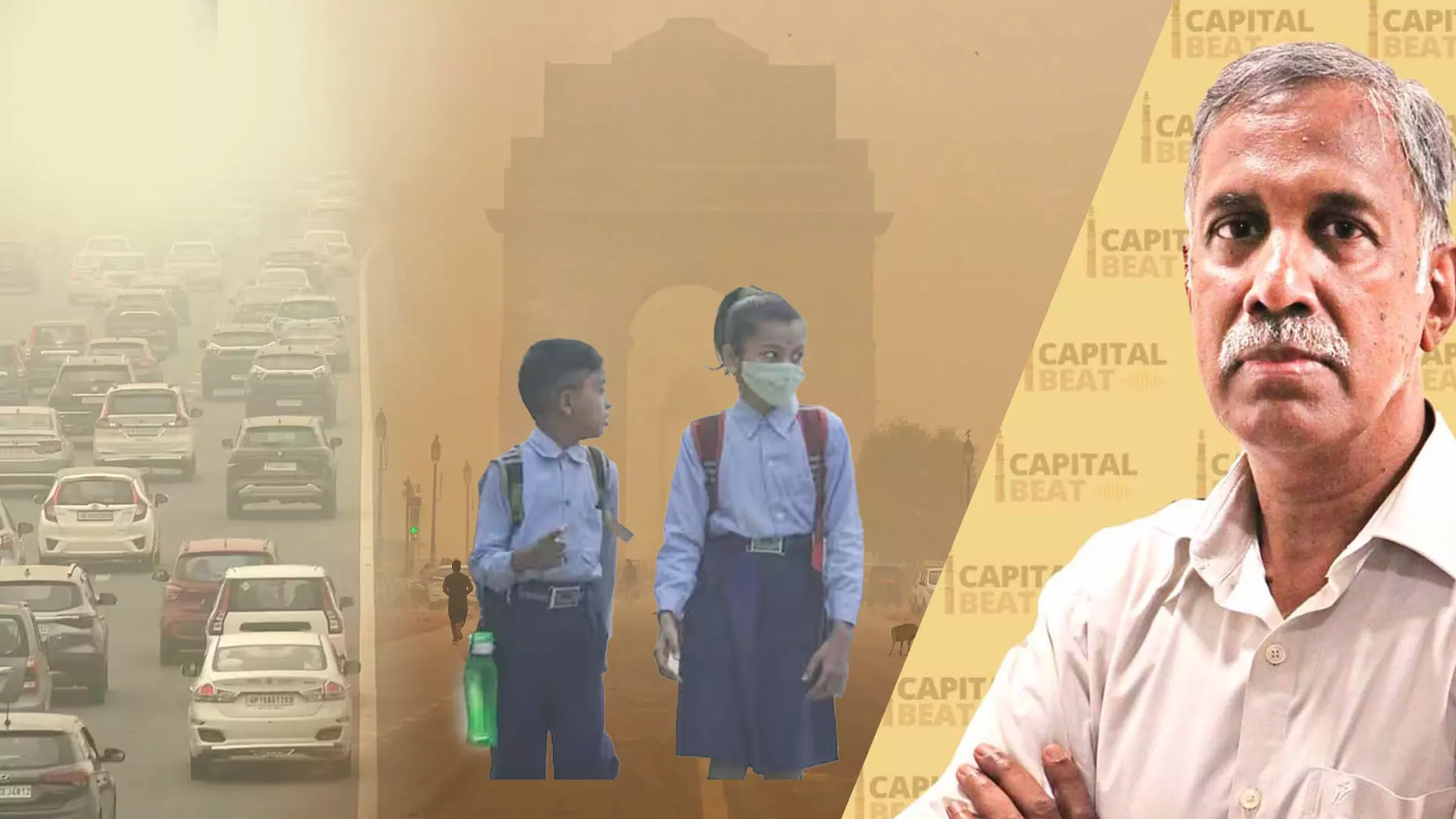
Delhi air pollution spikes post-Diwali: What is the way out? | Capital Beat
Experts warn 'severe plus' air may last till January; long-term fix needs cross-states political consensus.

Delhi and its neighbouring regions are facing dangerously high air pollution levels during Diwali. The Federal’s Editor-in-Chief S Srinivasan hosted the latest Capital Beat panel, featuring Prof Gufran Beig, Chair and Founder of SAFAR; Soumya Sarkar, senior Journalist; and Dr Rajesh Chawla, Pulmonology & Critical Care, Indraprastha Apollo Hospitals, Delhi. The discussion focused on rising AQI levels, health hazards, and potential mitigation strategies.
Extreme air quality and monitoring
Most monitoring stations in Delhi and the National Capital Region reported air quality index (AQI) readings above 450, classified as “severe plus”. Experts warn that these levels could persist until January, making the city one of the most hazardous places to live, particularly for children, the elderly, and individuals with underlying health conditions.
Prof Beig explained the technical limits of AQI measurements: “When it comes to 999, that means the monitor is set to a maximum of 1000, and the last reading it can show is 999 because it cannot touch 1,000.” He noted that some stations recorded values exceeding 1700–1800, reflecting extreme pollution spikes.
Health impact of particulate matter
Dr. Chawla described the effects of particulate matter on the lungs. Fine particles such as PM2.5 penetrate deep into lung tissue and can trigger inflammation, chronic obstructive pulmonary disease (COPD), bronchial asthma, coronary artery disease, and strokes. He noted that high pollutant levels exacerbate symptoms, increase medical interventions, and prolong recovery from infections.
Also Read: Diwali celebrations: Delhi, Jaipur report hundreds of burn injuries
He highlighted a seasonal surge in respiratory illnesses during winter months due to stagnant air, low humidity, and pollutants carried from neighbouring states: “There is a 20% increase in patients, particularly those suffering from respiratory illnesses, during this period.”
Even healthy individuals experience long-term effects, with repeated exposure potentially shortening life expectancy by several years and increasing risks for lung cancer, vascular diseases, and chronic respiratory conditions.
Contributing factors to winter pollution
Soumya Sarkar emphasised multiple causes of Delhi’s winter pollution, including vehicle emissions, industrial activity, construction dust, Diwali firecrackers, and stubble burning in Punjab, Haryana, and western Uttar Pradesh. She also highlighted meteorological conditions such as low wind speeds and temperature inversion that trap pollutants over the region.
Prof Beig cited data from the Centre for Science and Environment: vehicular emissions contribute 51.5% of pollution, emissions from neighbouring districts 34.9%, farm fires 8.1%, and dust 3.7%. He stressed that while meteorology is uncontrollable, reducing human-generated emissions remains critical.
Experts noted the increasing role of Diwali firecrackers in worsening pollution. The scale of bursting has grown exponentially over the past 15 years, surpassing public awareness campaigns and regulatory interventions.
Limitations of green crackers
The panel discussed the Supreme Court’s permission for limited use of “green crackers,” intended to reduce emissions. Experts warned that green crackers still emit 60–70% of pollutants compared to conventional firecrackers.
Prof Beig explained: “Green crackers are not a lasting solution. They reduce emissions partially, similar to switching from diesel to petrol or CNG, but they still contribute significant pollution.” Authorities face difficulty enforcing restrictions due to the open market for these products and widespread public participation during the festival.
Long-term mitigation strategies
Experts called for a comprehensive “air shed” approach that transcends political and administrative boundaries. This strategy would coordinate actions across all affected districts and states to target emissions from transport, biomass fuel, dust, and industry.
Prof Beig stressed: “Unless you are attacking the root cause of emissions with air shed–based strategies, the problem is not going to be solved in a shorter time.” Quick fixes like smoke towers, water guns, or artificial rain provide minimal relief and are insufficient for sustained improvement.
Soumya Sarkar added that bipartisan political support is essential for meaningful progress. Without multi-party consensus on pollution control as a public health priority, short-term gains will not materialize.
The human cost of prolonged exposure
Prolonged exposure to Delhi’s polluted air has measurable impacts on health efficiency and life expectancy. Dr. Chawla explained that repeated exposure prevents the body from adapting, intensifying respiratory and cardiovascular disease risk. Non-smokers face health risks comparable to smokers in other regions due to constant pollutant inhalation.
Experts highlighted the persistent strain on medical infrastructure, with patients requiring increased medication and extended recovery periods. Children, the elderly, and individuals with chronic diseases are particularly vulnerable.
The panel emphasised that while some short-term measures may reduce pollution spikes, only sustained, coordinated policies addressing emission sources can ensure long-term public health improvement.
The content above has been transcribed from video using a fine-tuned AI model. To ensure accuracy, quality, and editorial integrity, we employ a Human-In-The-Loop (HITL) process. While AI assists in creating the initial draft, our experienced editorial team carefully reviews, edits, and refines the content before publication. At The Federal, we combine the efficiency of AI with the expertise of human editors to deliver reliable and insightful journalism.

